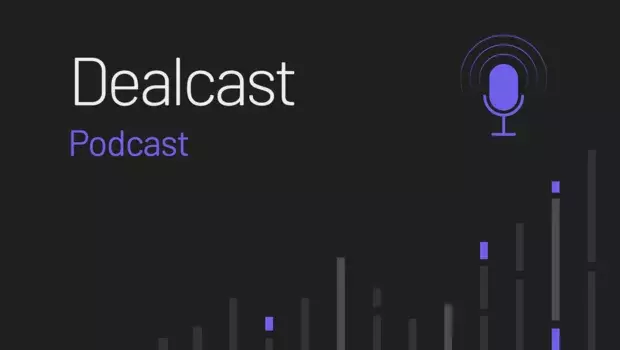Today, we’re joined by Ken Bisconti, co-head of SS&C Intralinks, who provides an exclusive preview of the SS&C Intralinks Deal Flow Predictor for Q4 2022.
The Deal Flow Predictor forecasts mergers and acquisitions (M&A) volume up to six months in advance of the market announcement.
Through insights into thousands of deals that come across our global desks annually, Intralinks has an early view of most M&A deals that are coming to market. We utilize that proprietary data to forecast anticipated volume, as will be announced by Refinitiv. Our proprietary insight into this deal flow gives us a view into global activity and anticipated volume six months before deal announcement, as six months is the average time for due diligence on our platform and before market announcement of those transactions.
Listen, and you’ll learn about:
- M&A activity for the first three quarters of the year
- Data-driven M&A global market prediction for Q4 2022
- Six-month regional outlook for Asia Pacific, Europe, the Middle East and Africa, North America and Latin America
- Trends and opportunities
Transcript
JULIE-ANNA: Welcome to Dealcast, the weekly M&A podcast presented to you by Mergermarket and SS&C Intralinks. I'm Julie-Anna Needham, a business journalist who's been covering M&A for a decade. In this episode, we're looking at the M&A trends highlighted in the latest deal flow predictor. This is based on data from Intralinks' due diligence platform. I'm joined by Ken Bisconti, co-head of SS&C Intralinks to discuss the findings from the Q4 2022 SS&C Intralinks Deal flow Predictor.
Hi, Ken. Thanks very much for joining me.
KEN: Hi, Julie-Anna.
JULIE-ANNA: So to begin with, can you briefly outline what the deal flow predictor is and what it's based on, please?
KEN: Yeah, happy to. The deal flow predictor is a quarterly research note that we put together based on the insights of tens of thousands of deals that come across our global deal desks in M&A due diligence. And basically, we're looking at the deals that get started in a particular quarter and the anticipated announcement activity that usually follows about six months after people enter diligence.
JULIE-ANNA: Great. Thank you. Can we look now at an overview of M&A activity globally. What have you seen in the first three quarters of 2022 and what are you expecting to see in this final quarter of the year?
KEN: Great question. I think it's probably on a lot of people's minds. We saw, I think, in Q1, we started to see early signs of market stress begin to coagulate at the end of last year as inflation started taking a global toll on financing costs per deals. And in Q1 of this year, we saw the lowest amount of re-announced deal flow on a trailing four quarters basis, of course exacerbated by the announcement of the war in Ukraine. In Q2, deal flow rebounded quite significantly to near resistance levels as we — that we saw in the height of 2021, so as the markets, at the time, seemingly priced in future rate hikes and other political-economic challenges into their forecasts and started to push ahead with grocer sales strategies.
Now, we're still wrapping up Q3, which tends to be a slower quarter due to the summer. But early indications are the markets are leveling off marginally from Q2. But we'll have a little more clarity after the quarter ends.
And I would say just to maintain some perspective, 2021 was just a phenomenal year from a deal volume standpoint. And we anticipate last year to be a benchmark for some time to come. But despite all the macro challenges that we're facing, globally and just financial and political issues, this year, surpassed every quarter of 2020 and 2019. So the markets are pretty healthy still when we zoom out of the chart if you will.
JULIE-ANNA: So looking now at the different regions, firstly, can you talk through what's been happening in the Asia-Pacific region? Which sectors there saw the most activity? And what the headwinds have been?
KEN: Yeah, happy to. So first to level set, each of the four quadrants that we track, APAC, as well as EMEA, Latin America, North America, saw fairly uniformly an uptick in deal flow in Q2 compared to Q1. We saw in APAC double-digit growth in the region. So the region is moving in the right direction. We're anticipating approximately a 10% growth in deal volume quarter on quarter in APAC, though still slightly negative year on year on Q2 from 2021, which of course, was a high point for multiple years.
We saw volume upticks in major markets like Australia, People's Republic of China, and South Korea. So a resurgent in major markets like these are pretty positive indicators for the region. APAC, of course, experienced a pretty harsh summer through extreme combination of typhoons and droughts. And that impacted some of PRC, Japan, South Korea. So we'll probably see a bit of impairment in Q3 this year.
Probably the biggest challenge that we're hearing about in the region is in People's Republic of China and their zero-COVID policy. The region and the world are anxious for them to be back at full capacity to tackle various shared issues we're going through.
JULIE-ANNA: Great. Thank you. And how does the APAC region differ to EMEA? What activity trend — what activity and trends are you seeing in the EMEA region?
KEN: Well, we're expecting double-digit growth in EMEA as well, quarter on quarter, moderate downside from 2021 to 2022. EMEA, of course, stands at the front line of absorbing the Ukrainian invasion and has heavy reliance and the need to substitute Russian energy. And that's manifesting in surging inflation and gas prices across the region. But despite these challenges, we saw nearly record deal flow in Q2, the second best quarter in volume going back to 2019.
So having such high volume at a time when the world is collectively experiencing economic and political headwinds could mean that sellers are struggling to keep up with inflation, and rising operating costs, and seeking exits. We'll see what type of deals and what valuations get announced in Q4 and Q1 of next year. Having this quantity of deals start in the region in Q2 indicates sellers are still willing to sell, and buyers are willing to invest in the region. We saw in particular strong performance out of France, Italy, and Spain in Q2.
JULIE-ANNA: Thank you. And looking towards the West now, the deal flow predicts is forecasting double-digit recovery in North American volumes in quarter four. What's driving that resurgence and what trends can we expect toward the end of the year? And can you put it into some kind of wider context for us, given the market is so volatile at the moment?
KEN: Julie-Anna, that's a great question. And it's important to maybe clarify for listeners that the DFP is a report communicating volume of new due diligence activity that happens in a quarter. And we saw in North America, again, quarter on quarter strong upside compared to what we heard in Q1. So we're expecting a strong upside in Q4 with the U.S. leading the way, Canada trailing a bit with moderate to flat growth. But those ultimate deal announcements and deal closes are certainly somewhat influenced by what additional market activity or volatility might occur since due diligence begins in Q2.
One insight we had by the way in the US was an uptick in bankruptcy or distress-related opportunities, both quarter on quarter and year on year. So keep in mind that the US, unlike EMEA, did not have any regulatory pillars that protected companies from filing for insolvency through COVID. The US obviously has an outsized impact globally in providing market confidence and direction. But again, like every territory we cover, seeing volume reach this level when we're all aware of the challenges we're facing can indicate a larger trend of companies struggling to maintain valuations and revenue expectations from 2021 and seeking exits.
JULIE-ANNA: Now, turning to Latin America, with a strong bounce-back expected, can you tell us more about the trends in the region, and what hurdles that seen this year, and how they've impacted the market?
KEN: We did see strong early-stage deal flow in Q2 which is a good sign for a potential rebound in Q4 of announced volume compared to Q3. Latin America has always born the brunt of market volatility from our vantage point. But keeping with global trends, it's been seen a strong resurgence. The major markets there have some transformative events to deal with this year, presidential elections in Brazil and Colombia, Argentina's debt crisis. But despite some of these potential policy-shifting events, we saw the strongest rebound quarter on quarter and year on year in that region.
JULIE-ANNA: And we've talked about it a bit already in this interview, but looking at the challenges we've seen, you mentioned Ukraine, rising interest rates, how do you expect some of those challenges to impact the rest of the year?
KEN: I think that, again, despite strong quarter-on-quarter growth in deal activity in Q2, uncertainty remains in the ultimately announced deals that will happen six-ish months later. And there are roughly — primarily, three concerns that were still seen as challenges. Interest rates and borrowing costs, of course, are the biggest concern, rates are already at their highest since 2008, and more hikes are being priced into growth strategies across the globe.
Now, this can be advantageous to acquirers who've secured capital commitments prior to the hikes. And we know there's lots of dry capital, dry powder in the private markets for instance. But acquirers coming to market with financing requirements are going to continue to experience credit tightness. And that will be a challenge.
Secondly, any escalation in Ukraine is going to present broad challenges from energy allocation to global food supplies. And it's the biggest thing that could destabilize global security order. Then finally, I would say China continuing its zero-COVID policy and the world's reliance on produce and consuming their consumption of global goods is maybe the third big, big challenge that we're watching so. We're excited about the quarter-on-quarter growth that we saw in the strong resurgence of activity in Q2. But there's still a cautionary flag out for what will result from that due diligence activity that's now in motion due to the growth of new deals in Q2.
JULIE-ANNA: Thank you. And finally, how can people read the latest deal flow predictor?
KEN: We would love for people to read the Deal Flow Predictor in its entirety.
JULIE-ANNA: Wonderful. Ken, thanks very much.
KEN: Thank you.
JULIE-ANNA: That was Ken Bisconti, co-head of SS&C Intralinks. Thanks for listening to this week's episode of Dealcast presented by Mergermarket and SS&C Intralinks. Please rate, review, and follow the podcast. You can find us on Apple podcasts, Spotify, or look out for your Mergermarket news alert. For more information, have a look at our show notes. Join us next week for another episode.
[MUSIC PLAYING]




